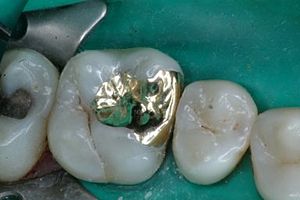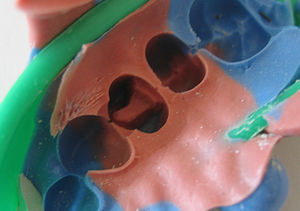- Inlays and onlays
-
"Onlay" redirects here. For the town in France, see Onlay, Nièvre.
Inlays and onlays Intervention ICD-9-CM 23.3 MeSH D007284 In dentistry, an inlay is an indirect restoration (filling) consisting of a solid substance (as gold or porcelain) fitted to a cavity in a tooth and cemented into place.[1] An onlay is the same as an inlay, except that it extends to replace a cusp. Crowns are onlays which completely cover all surfaces of a tooth.
Contents
Inlays
An impression of preparation for restoration with a DO gold inlay on tooth #5. The "DO" designation indicates that the gold serves as a restoration for the distal and occlusal surfaces of the tooth. This tooth was prepared and the inlay will be fabricated according to the R.V. Tucker method of gold inlay preparation. Notice how the line angles of the impression for the inlay are very sharp and precise; this is achieved using carbon-tipped stainless steel instruments. The salmon-colored polyvinylsiloxane impression material is less viscous than the blue and is able to capture better detail for the tooth being restored.
Sometimes, a tooth is planned to be restored with an intracoronal restoration, but the decay or fracture is so extensive that a direct restoration, such as amalgam or composite, would compromise the structural integrity of the restored tooth or provide substandard opposition to occlusal (i.e., biting) forces. In such situations, an indirect gold or porcelain inlay restoration may be indicated. When an inlay is used, the tooth-to-restoration margin may be finished and polished to such a super-fine line of contact that recurrent decay will be all but impossible. While these restorations might be ten times the price of direct restorations, the superiority of an inlay in terms of resistance to occlusal forces, protection against recurrent decay, precision of fabrication, marginal integrity, proper contouring for gingival (tissue) health, and ease of cleansing offers an excellent alternative to the direct restoration.
 An MO gold inlay on tooth #3, the "MO" designation indicating that the gold serves as a restoration for the mesial and occlusal surfaces of the tooth. This tooth was also restored according to the R.V. Tucker method. Notice how the gold appears to flow into the tooth structure, almost perfectly mimicking the natural contours and even allowing the specular reflection to continue over the margin from tooth to gold.
An MO gold inlay on tooth #3, the "MO" designation indicating that the gold serves as a restoration for the mesial and occlusal surfaces of the tooth. This tooth was also restored according to the R.V. Tucker method. Notice how the gold appears to flow into the tooth structure, almost perfectly mimicking the natural contours and even allowing the specular reflection to continue over the margin from tooth to gold.
Onlays
When decay or fracture incorporate areas of a tooth that make amalgam or composite restorations inadequate, such as cuspal fracture or remaining tooth structure that undermines perimeter walls of a tooth, an onlay might be indicated. Similar to an inlay, an onlay is an indirect restoration which incorporates a cusp or cusps by covering or onlaying the missing cusps. All of the benefits of an inlay are present in the onlay restoration. The onlay allows for conservation of tooth structure when the only alternative is to totally eliminate cusps and perimeter walls for restoration with a crown. Just as inlays, onlays are fabricated outside of the mouth and are typically made out of gold or porcelain. Gold restorations have been around for many years and have an excellent track record. In recent years, newer types of porcelains have been developed that seem to rival the longevity of gold. If the onlay or inlay is made in a dental laboratory, a temporary is fabricated while the restoration is custom-made for the patient. A return visit is then required to fit the final prosthesis. Inlays and onlays may also be fabricated out of porcelain and delivered the same day utilizing techniques and technologies relating to CAD/CAM dentistry. [2][3]
References
Further reading
- The Gold Inlay Instructional DVD, The Academy of R.V. Tucker Study Clubs, distributed by Jensen Industries.
- The Academy of CAD/CAM Dentistry
Prosthodontology (ICD-9-CM V3 23.2-23.6, ICD-10-PCS 0C?W-X) Fixed Prosthodontic Restorations Dental restoration: Bridge (Resin retained bridge, Rochette bridge) - Crown (Post and core) - Inlays and onlays - Veneer
Diagnostic wax-upRemovable Prosthodontic Restorations Prosthodontic considerations Maxillofacial Prosthodontics Other specialties
See alsoCategories:
Wikimedia Foundation. 2010.

